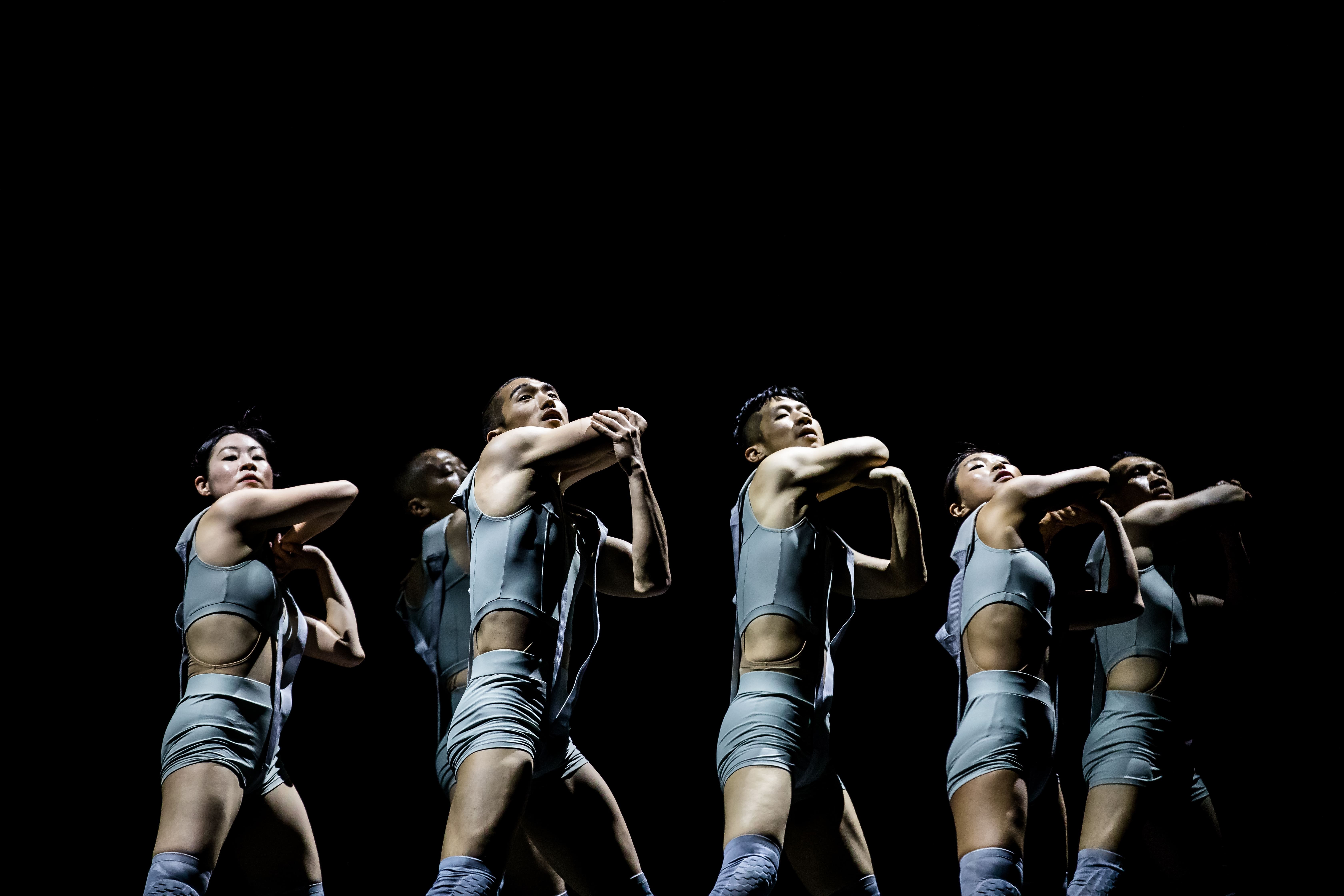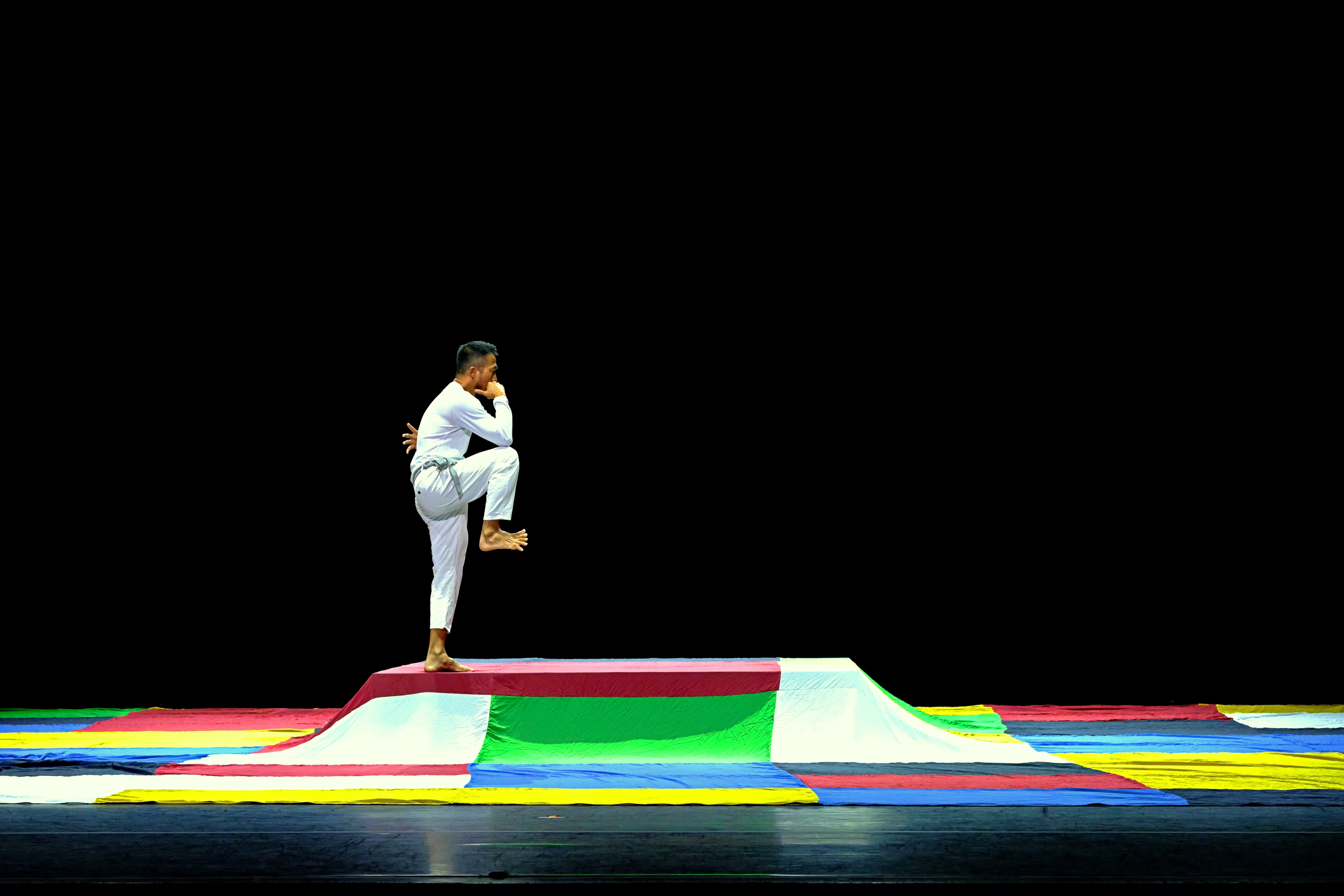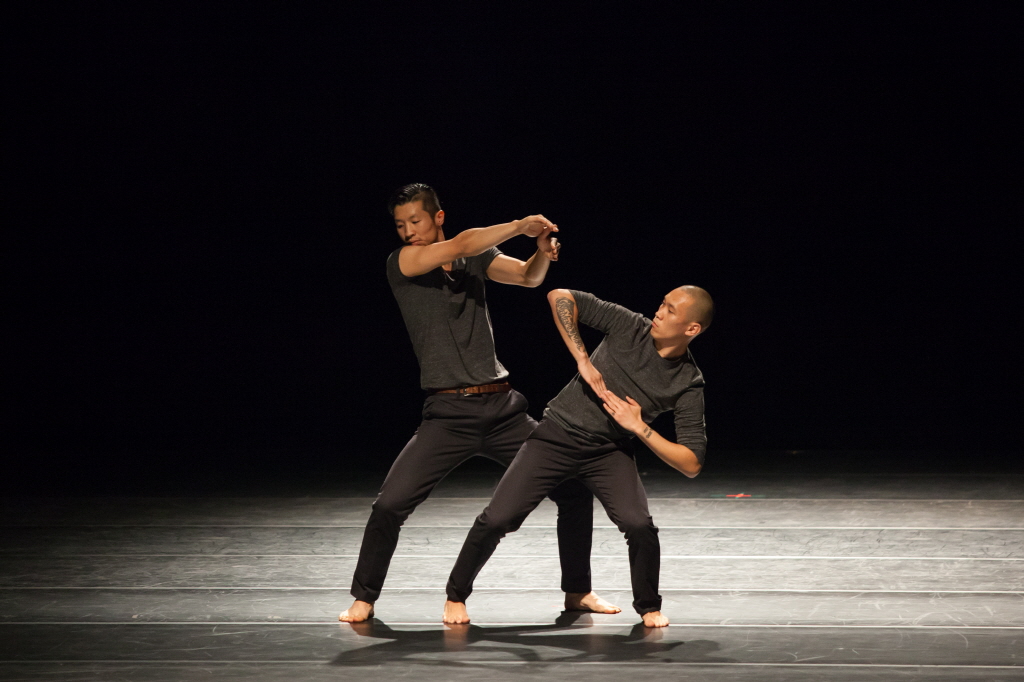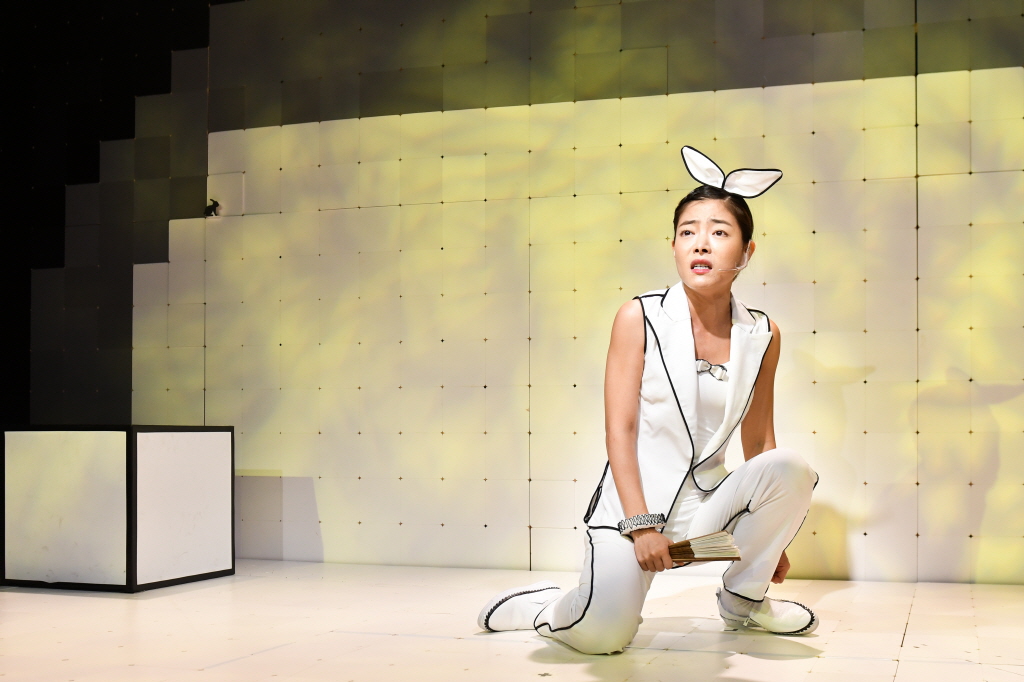Performance Info
Performance Info
About CompanyCOMPANY SIGA is an acronym combining the two Korean words, “시나브로 [sinabro]”, which means ‘little by little’ and "가슴에[gaseume]" which means ’into the heart’. The company practice a democratic working style that puts diverse movements and thoughts of all members together into one complete piece of art. Company SIGA keep ’Speed’, ‘Basic’ and ‘Body’ as the main three keywords of their group dance pieces, creating natural pace and flow.
Interviewee Artistic Director Lee, Jaeyoung
Representative Kwon, Hyuk
Interview
Q: How would you describe COMPANY SIGA?
Kwon Hyuk: We are an eight-member team that engages in joint creative activity with the aim of merging movement and thought into one entity. We spend a lot of time together in addition to our five weekly rehearsals, and we focus a lot on projects that allow us to concentrate on the body for the purpose of simplifying the body’s shape and energies.
Lee Jae-young: Our name in Korean, Sinabro, is a pure Korean word that means “something seeping through without one being aware of it.” We want our art to permeate people’s hearts in a similar way.
Q: What are the stories that are embodied by the “While” series, which is about being “shaken”? How is the initial 20-minute version different from the one-hour extended version?Kwon Hyuk: I was at a point in life where I was pummeled by the hardships that always accompany the task of making an important decision. This motivated me to create something on being “shaken,” which is the Korean way of expressing the emotional turmoil of such hardships. While doing some research, I came across the following: “We become shaken because we are human. Feeling shaken is natural: it’s because we are not perfect. All living things on Earth get shaken. Anything that cannot be shaken is dead.” These words made me realize that I was wrong to expect to never be shaken. We are told, from childhood, that we need to “grow up strong.” “While” conveys the message that people have every right to be shaken, because they are imperfect, by showing a series of shaking images. I also believe that, in order to endure being shaken, we need to be willing to empty ourselves. We wanted viewers to, through repetitive movements, experience such emptying. Our first version included images of shaking. On the other hand, the one-hour expanded version conveys the process by which shaking starts from deep within the human mind and turns into external shaking.
Q: You once introduced “ZERO” as “movement that takes me beyond my limits to a higher plane of freedom.” Can you elaborate on this?Kwon Hyuk: My reason for practicing is to gain the ability to dance completely freely. At some point along the road, I realized that the more I practice, the more I am trapping myself within the confines of dance. Nevertheless, I wanted to keep dancing and releasing my inner energy. “ZERO” began from the question “If I dance until I am literally gasping for air but do not feel mentally exhausted, can I ever experience true freedom through dance?” It questions how we can become free when the body reaches its physical limits as well as the nature of the movements that can emerge afterward.
Q: “Equilibrium” explores the relationships between balance and imbalance, as well as between reaction and counteraction, through the physical contact between two male dancers. What was the question that this project started from? What is the methodology of movement that was used to answer it?Lee Jae-young: We use the word “balance” when talking about our lives. For a social discussion of balance, however, I came to think that “equilibrium” may be a better term. People are all very different—in terms of not only social status but even things like height. “Equilibrium” explores how vastly different people create harmony. We believe that, once horizontality is achieved, it is destroyed by another energy and then returns to being horizontal—a process that repeats in an endless loop. We used physical contact and movements similar to mechanical motions, revolutions made around a certain point, and sliding. If you observe the system by which a machine works, the cogwheels turn in predictable ways. There are also parts that slide into place. We wanted to show, through the contact of bodies, the point at which revolutions occur and how sliding is done through repetitive processes—ultimately, how the transition from the structural to the systemic occurs. Finally, the dancers’ bodies are continuously shaking. The transition from systems and structures, after they’ve run their course, to movement of the body shows the chaos that defines movement. Through “Equilibrium,” we wanted to show, in succession, how the regular morphs into the irregular and how the irregular goes back to being regular.
Q: Please describe “Hit & Run,” one of your more recent creations that happens to be about baseball.Lee Jae-young: At first, I thought a lot about whether to make it plot-led or image-based. After discussing it, we decided to focus on our strengths as a group. COMPANY SIGA favors simple and repetitive movements. Although our movements may see trivial and without value, I believe that the repetition of such movements results in a powerful ability to communicate. We started by “collecting” the things that typically happen in a baseball stadium and attaching them together, like Lego pieces. This resulted in movements that we eventually formed categories for, and it was this categorization that made our dances more powerful metaphorically. At our first performance, we were worried about whether the audience would be able to understand this point. It was a relief to see people searching for baseball images—much like for a hidden picture search.
Q: You convert diverse formats of life into “movement energy.” COMPANY SIGA’s style has been described as “an honest mode of expression that, in lieu of sophisticated technique, uses endless repetitions of simple movements.” One word that is often used to summarize your style is “analog.” What is the choreographic style that you aim for? What kind of dancing do you want to be known for?Lee Jae-young: The members of COMPANY SIGA spend a lot of time sharing their lives with one another. The body is an amalgam of many parts of a person’s life. Everything we put into motion—whether it is physical acts or attitudes—is movement. The focus of our creative endeavors is thus to gather together such movements and use them to tell stories about human life.
Q: What is a COMPANY SIGA production (or productions) that has been spotlighted overseas? Why do you think it gained such attention?Lee Jae-young: “Equilibrium,” “ZERO,” and “While.” Our creations have a lot of repetition and emphasize what we want to show the audience. We toss a topic to the audience and force them to think about it, which is something that I feel has gained us attention outside of Korea. A lot of people also say that we, like traditional Korean paintings, embody the “beauty of empty space.” Our bodies are deeply immersed in the philosophies and social values of Korea. After thinking about how to express these philosophies and social values, we return, time and time again, to emphasizing repetition and simplification.
Q: What are your plans for international activity?Lee Jae-young: When I was a kid, I heard a lot about how “the most Korean things are the most global.” I agree: but we need to think about what it means for something to “be Korean.” I believe that the little things we feel in our day-to-day lives are very Korean. The thoughts I had today affect my work, and the more we can accumulate such trivial thoughts, the more powerful our stories become.
Kwon Hyuk: We will be going to London in the second half of 2022 for “While II.” I believe that everything I create is “Korean.” I want to continue working on projects that embody what I am really passionate about.
Q: What question are you wrestling with right now, as a choreographer?Lee Jae-young: I’m doing some theater projects alongside my COMPANY SIGA work. I enjoy it because experiencing a different genre gives me a lot of inspiration for dance. I’ve steered clear of storytelling thus far, but I’ve now become more curious about the process of making and telling stories.
Kwon Hyuk: In the studio, I feel free when I dance. When I perform that same dance on stage, a lot of that freedom disappears. In my search for how to narrow the gap between the stage and dance, I realized that the answer ultimately lies in the body. So, I want to learn how to not be tied down to certain movements and how to use my body.
Production Details
Major Productions〈While〉
〈While Ⅱ〉
〈Equilibrium〉
〈ZERO〉
〈Hit & Run〉
〈Rest〉
- 2021 The Place ‘A Festival of Korean Dance’, UK
- 2020 Yokohama Dance Collection ‘HOTPOT-Korea’, Japan
- 2019 OPEN LOOK Int’l Dance Festival, Russia
- 2019 Theatre Varia, Belgium
- 2018 Prisma Festival, Panama
- 2018 EDANCO: FESTIVAL INTERNA, Dominican Republic
www.companysiga.com
companysiga
companysiga
Production Details
- Director
Lee, Jaeyoung, Kwon, Hyuk
The Company SIGA began with the purpose of communicating and sympathising with our lives and people around us through their dancing. SIGA is an acronym which the company members coined using a Korean word, “시나브로[sinabro]”, and that means ‘little by little. Lee Jae-young, Ahn Ji-hyung, and Kwon Hyuk, those three choreographers are pursuing a group work style that puts diverse movements and thoughts of their own all together into one complete piece of art. In addition, they actively collaborate with artists of various genres to challenge new adventures for each piece of work and expand the spectrum of their dance "little by little".








 제공 ⓒ옥상훈.jpeg)
 제공 ⓒ옥상훈(0).jpeg)





 PREV
PREV




.jpg)
 Youngmo Choe.jpg)

.jpg)












